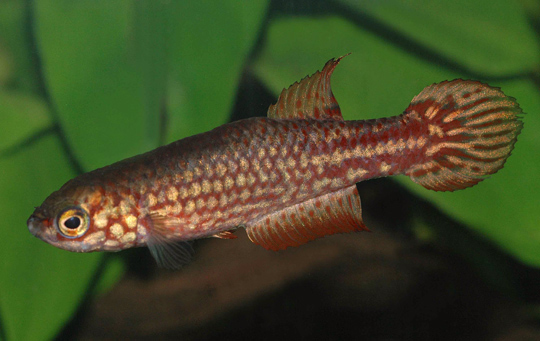| Rivulidae (Rivulines), subfamily: Cynolebiinae |
| 2.17 cm SL (male/unsexed) |
|
benthopelagic; freshwater; pH range: 3.5 - 4; depth range - 0 m |
| South America: seasonal pools in the Itanhaém river basin in southeastern Brazil. |
|
Dorsal soft rays (total): 13-16; Anal soft rays: 16-19. Diagnosed from other species of the genus Leptolebias except Leptolebias aureoguttatus by having four caudal neuromasts (vs. two), and horizontal golden lines on caudal fin in males (vs. no similar color pattern). Differs from Leptolebias aureoguttatus by possessing the following characters: two dark-red stripes on dorsal and ventral submarginal portion of caudal restricted to anterior portion of fin in males (vs. along all fin extension); male caudal-fin stripes parallel to fin rays, not branching posteriorly (vs. branching posteriorly); basal portion of dorsal fin with dark-orange small spots in males (vs. dark-red to dark-brown short transverse bars); and five or six lateral mandibular neuromasts (vs. three or four). Can also be differentiated from all congeners in the number of caudal fin rays, 27-31 vs. 25-28 (Ref. 75888).
Description: Caudal fin elliptical. Longitudinal series of scales 25-27; transverse series of scales 8 (Ref. 75888). |
| Occurs in shallow (about 10-40 cm deep), temporary channels within dense rainforest, in tea-colored and acidic (pH 3.5-4.0) water with litter at the bottom (Ref. 75888). |
|
Not Evaluated (N.E.) Ref. (130435)
|
| harmless |
|
Source and more info: www.fishbase.org. For personal, classroom, and other internal use only. Not for publication.

